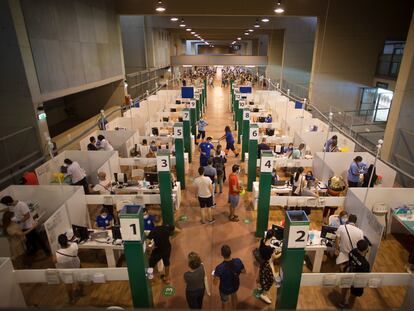Coronavirus transmission in Spain falls for the first time in more than a month
But hospitals continue to face mounting pressure and the number of weekly Covid-19 deaths has nearly tripled in the past week

The coronavirus incidence rate in Spain has fallen for the first time in more than a month. This data point had been rising for 35 straight days since June 22, when the 14-day cumulative number of cases per 100,000 inhabitants came in at 92. The fall has been small, but it suggests a change of trend. According to the latest Health Ministry report, released Wednesday evening, the incidence rate now stands at 699.8 cases, down from 702 on Tuesday.
Spanish Health Minister Carolina Darias said this confirmed a change that was heading towards a “plateau” that was likely to remain in place for some time due to the difference in the contagion rates among the regions.
“We are beginning to stabilize the curve and flatten it,” Darias said on Wednesday at a news conference to present the latest figures. She explained that the goal was to consolidate this trend and lower the incidence rate to lower levels “to stop the spread of the virus.” “The rises in incidence among unvaccinated people are seen in all regions. The measures that the regions are adopting are beginning to take effect,” she added.
I think a clear fall will not begin to be seen until mid-August. Now we have some regions that rise and others that fall, so we don’t have a clear stabilizationAlberto Infante, professor at the National Health School at the Carlos III Health Institute
Coronavirus transmission rates are falling in the regions hardest hit by the fifth wave – Catalonia, Castilla y León, Navarre, Asturias and Aragón. But they continue to rise in the rest of Spain’s 17 regions, which are responsible for containing the pandemic in their territories, as well as the Covid-19 vaccination drive. The biggest rises are being seen in La Rioja, Madrid and the Balearic Islands. The latest Health Ministry report recorded 27,149 new coronavirus cases and added 73 deaths to the official toll.
Meanwhile, pressure continues to rise on Spain’s hospitals. Darias, however, indicated that this rise is happening at a slower rate than in previous days. A total of 9,672 people are in hospital with Covid-19 – up 150 since Tuesday and 1,417 since last week – and there are 1,593 Covid-19 patients in intensive care units (ICUs), a rise of 59 from Tuesday and 413 from seven days ago.
The number of Covid-19 deaths is also increasing, although the number is much lower than in previous coronavirus waves in Spain, when hundreds were recorded every day. According to the Health Ministry report, 178 people have died after testing positive for Covid-19 in the last seven days. This number is likely to be higher, however, given the delays with death notifications. Even still, this number is nearly triple the 67 weekly fatalities reported a week ago, and is six times greater than what was reported half a month ago, when the weekly figure did not exceed 30.
Experts agree with the health minister that the epidemiological curve will continue to plateau for some time. “I think a clear fall will not begin to be seen until mid-August. Now we have some regions that rise and others that fall, so we don’t have a clear stabilization,” said Alberto Infante, a professor at the National Health School at the Carlos III Health Institute. “The pressure on hospitals will remain high and will probably continue to rise, and the mortality rate will continue rising. It will rise less than in previous waves, but it will start to become significant, which will cause unease. We have shot ourselves in the foot of the tourism industry for deescalating [coronavirus restrictions] too quickly.”
Fernando Rodríguez Artalejo, a professor of Public Health at Madrid’s Autonomous University (UAM), added that “the incidence among the younger groups, where there have been most contagions, is already seen to be falling significantly.” According to Artalejo, this is the first step towards a downward trend that will consolidate in August, “and from then on, hospital admissions and fatalities will also fall.”
Capacity at soccer matches
Darias on Wednesday also attended the weekly meeting of the Inter-Territorial Council of the National Health System, which brings together health chiefs from the central and regional governments. At this meeting, the Health Ministry proposed that the regions agree to a uniform set of criteria to decide the safe capacity of venues ahead of the next soccer season in Spain, according to two sources familiar with the meeting. The goal is to set limits on capacity based on the cumulative incidence rate of the areas where games will be held and ensure the regions apply the same conditions.
The vaccination of pregnant women and adolescents was also discussed by the council. Gynecologists in public hospitals have asked for the immunization drive of pregnant women to be accelerated following a spike in ICU admissions among expectant mothers. Three pregnant women have died from Covid-19 in the last month. The council said that “the vaccination of pregnant women should not cause any doubt,” according to the same two sources.
With respect to the immunization of adolescents, the council announced that Spain’s expert group on vaccines will take into account “the adverse effects” recorded among teens, but continued to believe the benefits outweighed the risks.
English version by Melissa Kitson.
Tu suscripción se está usando en otro dispositivo
¿Quieres añadir otro usuario a tu suscripción?
Si continúas leyendo en este dispositivo, no se podrá leer en el otro.
FlechaTu suscripción se está usando en otro dispositivo y solo puedes acceder a EL PAÍS desde un dispositivo a la vez.
Si quieres compartir tu cuenta, cambia tu suscripción a la modalidad Premium, así podrás añadir otro usuario. Cada uno accederá con su propia cuenta de email, lo que os permitirá personalizar vuestra experiencia en EL PAÍS.
¿Tienes una suscripción de empresa? Accede aquí para contratar más cuentas.
En el caso de no saber quién está usando tu cuenta, te recomendamos cambiar tu contraseña aquí.
Si decides continuar compartiendo tu cuenta, este mensaje se mostrará en tu dispositivo y en el de la otra persona que está usando tu cuenta de forma indefinida, afectando a tu experiencia de lectura. Puedes consultar aquí los términos y condiciones de la suscripción digital.
More information
Últimas noticias
Most viewed
- Reinhard Genzel, Nobel laureate in physics: ‘One-minute videos will never give you the truth’
- Oona Chaplin: ‘I told James Cameron that I was living in a treehouse and starting a permaculture project with a friend’
- Pablo Escobar’s hippos: A serious environmental problem, 40 years on
- Why we lost the habit of sleeping in two segments and how that changed our sense of time
- Charles Dubouloz, mountaineering star, retires at 36 with a farewell tour inspired by Walter Bonatti









































